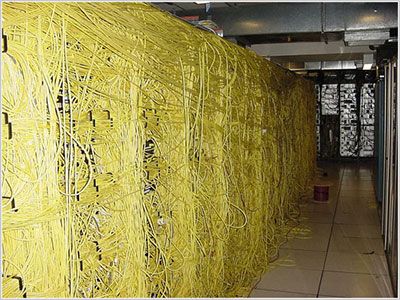Dependency Injection
Organization is essential to scale. Compare the two images of cabling a data center:


Obviously, the top image appears much more organized. I don’t think it is accidental that the better organized approach is visible in the larger data center. In order to scale, you need organization. If you have a small number of servers, a haphazard cabling scheme is less likely to impact your ability to trace and fix network problems. Such an approach would not work for a million-node data center.
The same is true of code. Without many of the visual cues we use to navigate the real world, tracking code can be very difficult. Thus, code can degenerate into chaos as fast or faster than physical devices. Indeed, the long standing name for poorly organized code is “Spaghetti Code” which is an analogy to the same kind of linear mess we can visualize with the network cables.
Dependency injection provides a tool to help minimize the chaos. Instead of wires run across the data center direct from one machine to another, the well organized scheme routes them to intermediate switches and routers in a standardized way. Just so, dependency injection provides an mediator between components, removing the need for one component to know the approach used to create the specific instance.
The guiding rule is that dependency injection separates object use from object construction.
Continue reading